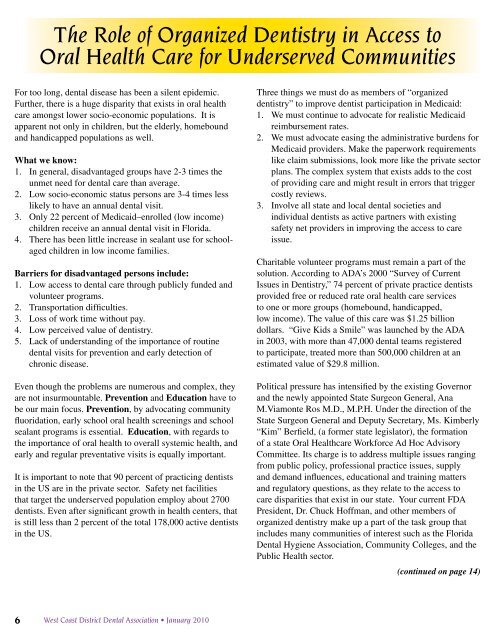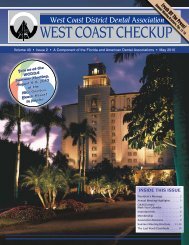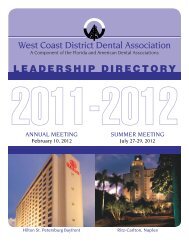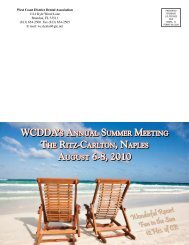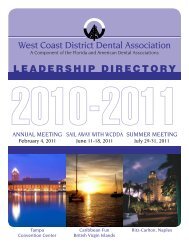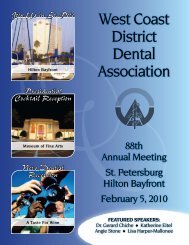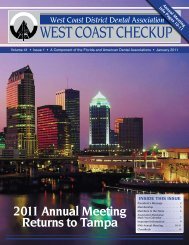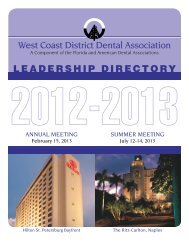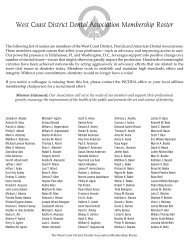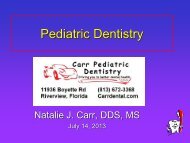Focus on St. Petersburg - West Coast Dental Association
Focus on St. Petersburg - West Coast Dental Association
Focus on St. Petersburg - West Coast Dental Association
You also want an ePaper? Increase the reach of your titles
YUMPU automatically turns print PDFs into web optimized ePapers that Google loves.
The Role of Organized Dentistry in Access to<br />
Oral Health Care for Underserved Communities<br />
For too l<strong>on</strong>g, dental disease has been a silent epidemic.<br />
Further, there is a huge disparity that exists in oral health<br />
care am<strong>on</strong>gst lower socio-ec<strong>on</strong>omic populati<strong>on</strong>s. It is<br />
apparent not <strong>on</strong>ly in children, but the elderly, homebound<br />
and handicapped populati<strong>on</strong>s as well.<br />
What we know:<br />
1. In general, disadvantaged groups have 2-3 times the<br />
unmet need for dental care than average.<br />
2. Low socio-ec<strong>on</strong>omic status pers<strong>on</strong>s are 3-4 times less<br />
likely to have an annual dental visit.<br />
3. Only 22 percent of Medicaid–enrolled (low income)<br />
children receive an annual dental visit in Florida.<br />
4. There has been little increase in sealant use for schoolaged<br />
children in low income families.<br />
Barriers for disadvantaged pers<strong>on</strong>s include:<br />
1. Low access to dental care through publicly funded and<br />
volunteer programs.<br />
2. Transportati<strong>on</strong> difficulties.<br />
3. Loss of work time without pay.<br />
4. Low perceived value of dentistry.<br />
5. Lack of understanding of the importance of routine<br />
dental visits for preventi<strong>on</strong> and early detecti<strong>on</strong> of<br />
chr<strong>on</strong>ic disease.<br />
Even though the problems are numerous and complex, they<br />
are not insurmountable. Preventi<strong>on</strong> and Educati<strong>on</strong> have to<br />
be our main focus. Preventi<strong>on</strong>, by advocating community<br />
fluoridati<strong>on</strong>, early school oral health screenings and school<br />
sealant programs is essential. Educati<strong>on</strong>, with regards to<br />
the importance of oral health to overall systemic health, and<br />
early and regular preventative visits is equally important.<br />
It is important to note that 90 percent of practicing dentists<br />
in the US are in the private sector. Safety net facilities<br />
that target the underserved populati<strong>on</strong> employ about 2700<br />
dentists. Even after significant growth in health centers, that<br />
is still less than 2 percent of the total 178,000 active dentists<br />
in the US.<br />
Three things we must do as members of “organized<br />
dentistry” to improve dentist participati<strong>on</strong> in Medicaid:<br />
1. We must c<strong>on</strong>tinue to advocate for realistic Medicaid<br />
reimbursement rates.<br />
2. We must advocate easing the administrative burdens for<br />
Medicaid providers. Make the paperwork requirements<br />
like claim submissi<strong>on</strong>s, look more like the private sector<br />
plans. The complex system that exists adds to the cost<br />
of providing care and might result in errors that trigger<br />
costly reviews.<br />
3. Involve all state and local dental societies and<br />
individual dentists as active partners with existing<br />
safety net providers in improving the access to care<br />
issue.<br />
Charitable volunteer programs must remain a part of the<br />
soluti<strong>on</strong>. According to ADA’s 2000 “Survey of Current<br />
Issues in Dentistry,” 74 percent of private practice dentists<br />
provided free or reduced rate oral health care services<br />
to <strong>on</strong>e or more groups (homebound, handicapped,<br />
low income). The value of this care was $1.25 billi<strong>on</strong><br />
dollars. “Give Kids a Smile” was launched by the ADA<br />
in 2003, with more than 47,000 dental teams registered<br />
to participate, treated more than 500,000 children at an<br />
estimated value of $29.8 milli<strong>on</strong>.<br />
Political pressure has intensified by the existing Governor<br />
and the newly appointed <strong>St</strong>ate Surge<strong>on</strong> General, Ana<br />
M.Viam<strong>on</strong>te Ros M.D., M.P.H. Under the directi<strong>on</strong> of the<br />
<strong>St</strong>ate Surge<strong>on</strong> General and Deputy Secretary, Ms. Kimberly<br />
“Kim” Berfield, (a former state legislator), the formati<strong>on</strong><br />
of a state Oral Healthcare Workforce Ad Hoc Advisory<br />
Committee. Its charge is to address multiple issues ranging<br />
from public policy, professi<strong>on</strong>al practice issues, supply<br />
and demand influences, educati<strong>on</strong>al and training matters<br />
and regulatory questi<strong>on</strong>s, as they relate to the access to<br />
care disparities that exist in our state. Your current FDA<br />
President, Dr. Chuck Hoffman, and other members of<br />
organized dentistry make up a part of the task group that<br />
includes many communities of interest such as the Florida<br />
<strong>Dental</strong> Hygiene Associati<strong>on</strong>, Community Colleges, and the<br />
Public Health sector.<br />
(c<strong>on</strong>tinued <strong>on</strong> page 14)<br />
6 <strong>West</strong> <strong>Coast</strong> District <strong>Dental</strong> Associati<strong>on</strong> • January 2010


